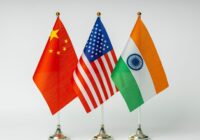The only real solution to nuclear security is to strengthen the existing Nonproliferation Treaty.
At the end of March, roughly 120 nations concluded the first round of negotiations on a new treaty to ban nuclear weapons. Visibly absent from the conference were the five permanent members of the United Nations Security Council: China, France, Russia, the United Kingdom and the United States. Coincidentally, these are the only five nations legally allowed to possess nuclear weapons under the terms of the Nuclear Nonproliferation Treaty (NPT), which has served as the cornerstone of nuclear order since entering into force in 1970.
Considering the NPT mandates the five recognized nuclear nations make efforts “in good faith” toward nuclear disarmament, their absence from the March negotiations was noteworthy. But these five states were not the only governments to object to the negotiations or ban treaty. The additional four nations possessing nuclear weapons — India, Israel, North Korea and Pakistan — all abstained or voted against the negotiations. With every single nuclear power seemingly opposed to these talks, it is clear that a new treaty is not the answer to nuclear disarmament.
Rather than focus on the creation of a new treaty, which is nothing more than a political statement hindering practical progress toward disarmament, the United Nations and its members must instead work to strengthen the NPT. The focus should remain on a multilateral effort to strengthen the current nonproliferation and disarmament regimes. Three of the four aforementioned nuclear powers currently not party to the NPT pose a significant nuclear threat, and their entry into the framework must be made paramount.
After the negotiations for a new treaty were postponed until mid-June, the news has been dominated by the rising tensions between the US and North Korea, which was once party to the NPT. Since withdrawing, however, it has created a thriving nuclear weapons program, along with a dangerous missile program. The development of new types of missiles, such as the Pukguksong-2, and the looming threat of a new nuclear test have put the US, South Korea and Japan on high alert. Kim Jong-un has repeatedly and publicly threatened the United States and its allies with nuclear strikes. Vowing to proceed “at full speed” with its nuclear program, North Korea poses not only a threat to its neighbors, but to the global nonproliferation regime as well.
Aside from North Korea, both Pakistan and India represent a considerable nuclear threat. Facing attacks from extremists, many in Pakistan’s Atomic Energy Commission worry about the security of the nation’s arsenal. A Pakistani security report stated that extremist groups maintained a presence in every province of the country, while urging the importance to strengthen Pakistan’s counterterrorism apparatus. Notably, India has become a target of many extremist groups within Pakistan as well. With tensions between New Delhi and Islamabad on the rise again, coupled with concerns over the security of Pakistan’s nuclear weapons, the likelihood of a nuclear war erupting between the two states is alarmingly high.
In order to advance the cause of nuclear disarmament, India, Pakistan and North Korea must be brought into the framework of the treaty — whether this means solving long-standing border disputes or providing security guarantees. A meaningful effort toward disarmament cannot be made when the largest threats remain outside the regime.
THE NEW BAN TREATY
The greatest problem facing the nonproliferation regime is the creation of a new ban treaty, which would be used as an “alternative forum” to the NPT. Currently, the NPT requires that signatory nations submit to inspections by the International Atomic Energy Agency (IAEA). The IAEA serves as the enforcement arm of the NPT, under Article III of the treaty, mandating that all non-weapons states allow the IAEA to investigate and verify that they are complying with the treaty.
 A new ban treaty would presumably create a new set of rules and institutions, or potentially none at all. Nations leaving the NPT to join this rival system will weaken the authority of the NPT, leaving the members of the UN Security Council and their allies — who object to the proposed ban treaty — alone and the world divided between two rival frameworks for nuclear security. This would accomplish nothing. The four non-NPT nuclear powers will not sign onto this new treaty, and there is no incentive for the recognized nuclear nations to sign onto a new treaty that they would immediately be in violation of.
A new ban treaty would presumably create a new set of rules and institutions, or potentially none at all. Nations leaving the NPT to join this rival system will weaken the authority of the NPT, leaving the members of the UN Security Council and their allies — who object to the proposed ban treaty — alone and the world divided between two rival frameworks for nuclear security. This would accomplish nothing. The four non-NPT nuclear powers will not sign onto this new treaty, and there is no incentive for the recognized nuclear nations to sign onto a new treaty that they would immediately be in violation of.
The only real solution to nuclear security is to strengthen the NPT, meaning further prevention of horizontal proliferation and bringing the four non-signatory nuclear powers into the treaty by any means necessary. Second, the nuclear powers must recommit to arms control agreements, such as the Plutonium Management and Disposition Agreement in order to illustrate their commitment to disarmament. These strengthening actions will do more to control the spread of nuclear weapons than a ban treaty, which does not address the current issues facing the nonproliferation and disarmament regimes.
*[Young Professionals in Foreign Policy is a partner institution of Fair Observer.]
The views expressed in this article are the author’s own and do not necessarily reflect Fair Observer’s editorial policy.
Photo Credit: Everlite
Support Fair Observer
We rely on your support for our independence, diversity and quality.
For more than 10 years, Fair Observer has been free, fair and independent. No billionaire owns us, no advertisers control us. We are a reader-supported nonprofit. Unlike many other publications, we keep our content free for readers regardless of where they live or whether they can afford to pay. We have no paywalls and no ads.
In the post-truth era of fake news, echo chambers and filter bubbles, we publish a plurality of perspectives from around the world. Anyone can publish with us, but everyone goes through a rigorous editorial process. So, you get fact-checked, well-reasoned content instead of noise.
We publish 2,500+ voices from 90+ countries. We also conduct education and training programs
on subjects ranging from digital media and journalism to writing and critical thinking. This
doesn’t come cheap. Servers, editors, trainers and web developers cost
money.
Please consider supporting us on a regular basis as a recurring donor or a
sustaining member.
Will you support FO’s journalism?
We rely on your support for our independence, diversity and quality.






